Discover 10 hidden attractions, cool sights, and unusual things to do in Colorado National Monument (United States). Don't miss out on these must-see attractions: Grand View Spire, Coke Ovens, and Pipe Organ. Also, be sure to include Terra Tower in your itinerary.
Below, you can find the list of the most amazing places you should visit in Colorado National Monument (Colorado).
Table of Contents
Grand View Spire
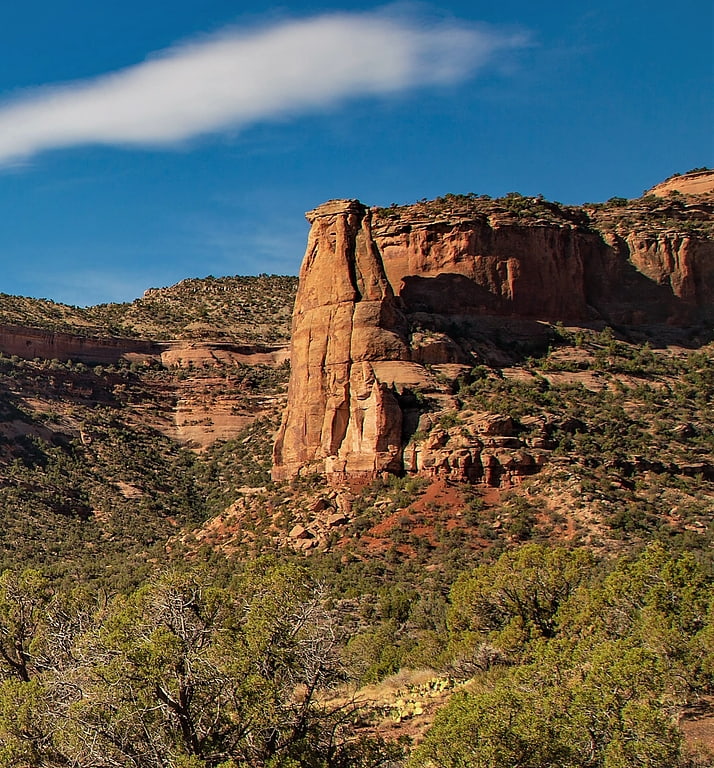
Grand View Spire is a 5,821-foot-elevation sandstone pillar located in Colorado National Monument, in Mesa County of western Colorado, United States. This 400-foot tower is situated on the west side of Monument Canyon, one mile southeast of the monument's visitor center, and 9 miles west of the community of Grand Junction. It is also 0.32 mile immediately south of Independence Monument, and 0.27 mile northwest of another climbing destination, Kissing Couple. Its unofficial name relates to its position at the tip of Grand View Overlook, one of several scenic viewpoints along Rim Rock Drive.[1]
Coke Ovens
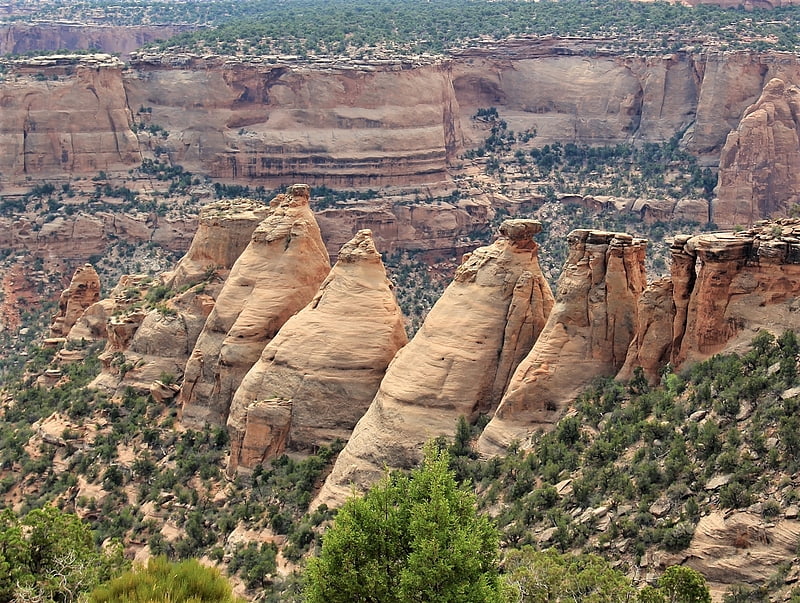
Coke Ovens is a 5,962-foot-elevation linear set of pillars located in Colorado National Monument, in Mesa County of western Colorado, United States. This iconic landmark is situated on the west side of Monument Canyon, two miles south of the monument's visitor center, and 9 miles west of the community of Grand Junction. It is also one mile south of Kissing Couple, and both can be seen from viewpoints along Rim Rock Drive. It is so named because the rounded shape resembles beehive coke ovens that were used in the nineteenth century to convert bituminous coal into coke, which was then used for smelting iron.[2]
Pipe Organ
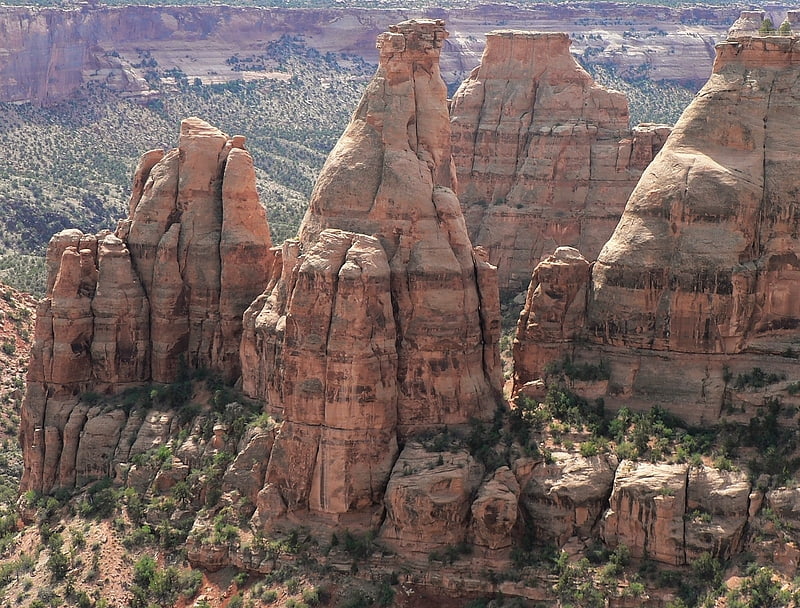
Summit in Colorado. Pipe Organ is a 5,731-foot-elevation sandstone pillar located in Colorado National Monument, in Mesa County of western Colorado, United States. This 400+ foot tower is situated in Wedding Canyon, less than one-half mile east of the monument's visitor center, and 9 miles west of the community of Grand Junction. It is also immediately northwest of another popular climbing destination, Independence Monument, and both can be seen from viewpoints along Rim Rock Drive. The first ascent of the summit was made January 31, 1961, by John Auld, Gary Ziegler, Jim Dyson, and John Kuglin. Pipe Organ has a subsidiary summit unofficially named Organ Pipe Spire on the east aspect, which the National Park Service refers to as Praying Hands. This 325-foot-high subsidiary peak was originally named Squall Spire in 1976 by Harvey T. Carter of the first ascent party.[3]
Terra Tower
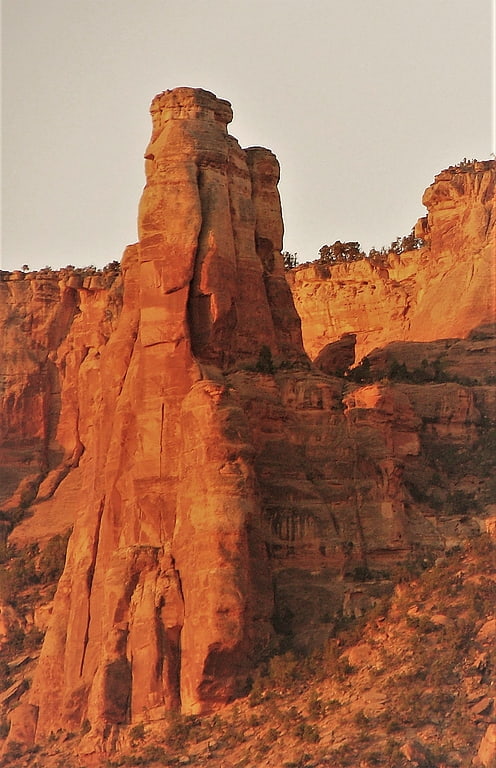
Summit. Terra Tower is a 5,790-foot-elevation sandstone pillar located in Colorado National Monument, in Mesa County of western Colorado, United States. This 350-foot-high tower is situated on the Redlands escarpment, approximately seven miles west of the community of Grand Junction. Topographic relief is significant as it rises 1,000 feet above the Tiara Rado Golf Course in approximately one-half mile. The first ascent of the summit was made in 1979 by Harvey Carter and Tom Merrill via the class 5.11 route, Way Bazaar.[4]
Sentinel Spire
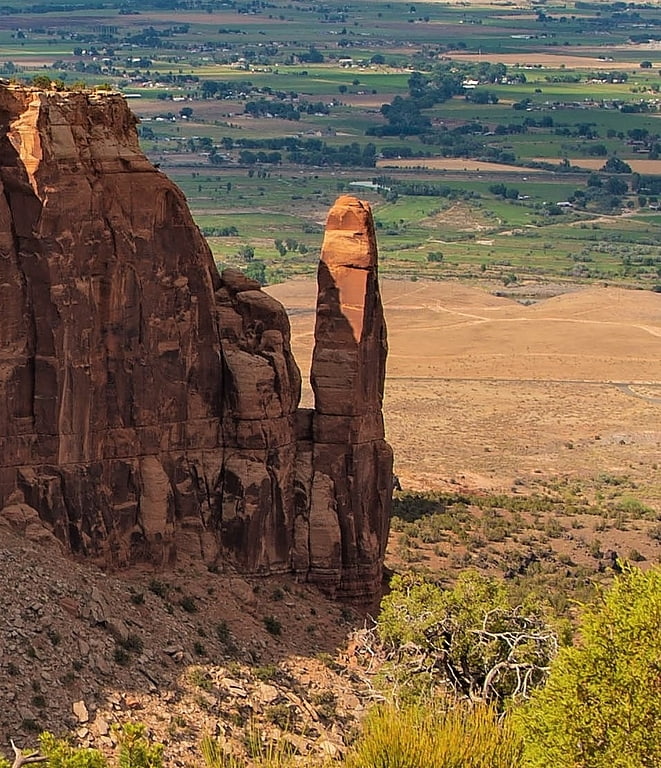
Summit in Colorado. Sentinel Spire is a 5,500-foot-elevation sandstone pillar located in Colorado National Monument, in Mesa County of western Colorado, United States. This 200-foot freestanding tower is situated in Wedding Canyon, one-half mile east of the monument's visitor center, and 9 miles west of the community of Grand Junction. It is also immediately south of Window Rock, and north of another climbing destination, Pipe Organ, both of which can be seen from viewpoints along Rim Rock Drive. The first ascent of the summit was made May 3, 1960, by Layton Kor, Harvey Carter, and John Auld via the class 5.10 route, Fast Draw. This was the day before the climbers also made the first ascent of nearby Kissing Couple. The first solo ascent was made by Ron Olevsky in March 1976, and the first free ascent was made by Andy Petefish and John Christenson in 1978. Some climbers refer to Sentinel Spire as Watusi Spear.[5]
Saddlehorn
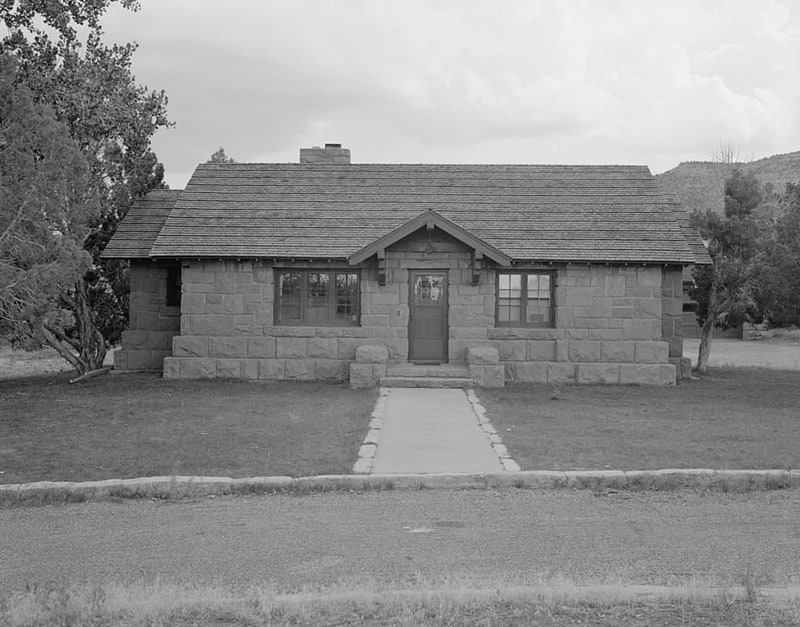
Heritage building in Mesa County, Colorado. The Saddlehorn Caretaker's House and Garage, also known as the Stone House, the Rock House, and the Superintendent's Quarters is a house and asset listed as part of the National Register of Historic Places located in the Colorado National Monument.[6]
Saddlehorn Comfort Station
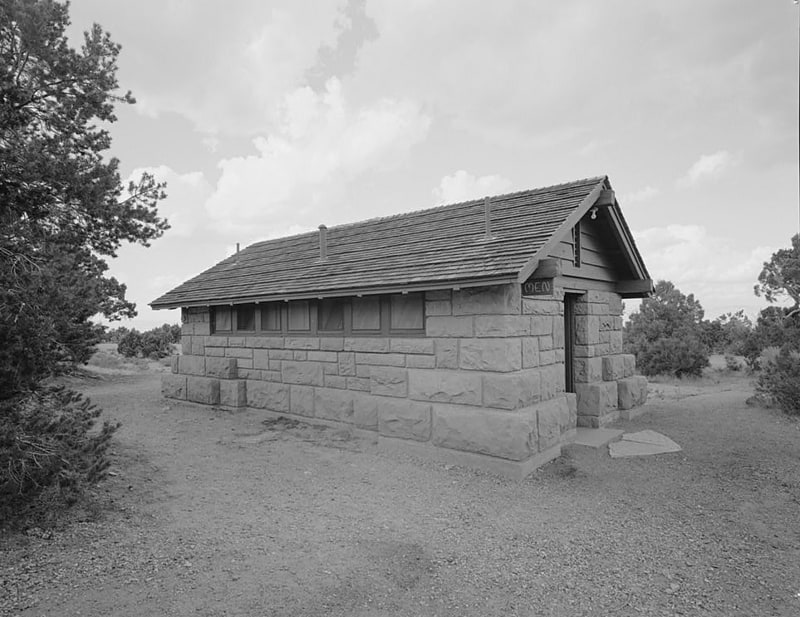
Historical landmark in Mesa County, Colorado. The Saddlehorn Comfort Station is one of a group of related structures listed on the National Register of Historic Places in Colorado National Monument. The comfort station and the nearby caretaker's house, garage and the Saddlehorn Utility Area Historic District feature a consistent interpretation of the National Park Service Rustic style, featuring coursed ashlar sandstone masonry and log-supported roof structure. The comfort station was designed in 1936 by W.G. Carney of the National Park Service Branch of Plans and Designs, and built by labor from the Works Progress Administration and the Civilian Conservation Corps. Plans specified not only the general layout of the house and garage, but the specific dimensions of each stone and its location, using a technique of "built by detail".
The comfort station is located at the intersection of Rim Rock Drive and the Saddlehorn Loop, named after a distinctive nearby rock formation. Construction was carried out by craftsmen, known as LEM's (Local Experienced Men), with suitable skills, reputedly stonemasons of Italian descent. Much of the material came from Rim Rock Drive construction. The comfort station was built by the men of CCC camp NM-2-C.
The three Saddlehorn National Register properties were nominated to the National Register of Historic Places as a multiple property submission on the basis of their related design and history.[7]
Saddlehorn Utility Area Historic District

Historical landmark in Mesa County, Colorado. The Saddlehorn Utility Area Historic District in Colorado National Monument comprises a complex of park service buildings, designed by the National Park Service Branch of Plans and Designs in the National Park Service Rustic style. The primary designer was National Park Service architect Kenneth M. Saunders, who employed the local red sandstone in the buildings, which included shops, fuel shed, repair and storage buildings. The buildings were constructed in 1941 by Public Works Administration and Civilian Conservation Corps labor.
The utility area is located at the intersection of Rim Rock Drive and the Saddle horn Loop, named after a distinctive nearby rock formation. It is separated from the caretaker's house by a low hill. Construction was carried out by craftsmen, known as LEM's (Local Experienced Men), with suitable skills, reputedly stonemasons of Italian descent. Much of the material came from Rim Rock Drive construction.
The three Saddlehorn National Register properties were nominated to the National Register of Historic Places as a multiple property submission on the basis of their related design and history. The utility area was built by CCC camp NM-2-C.[8]
Colorado National Monument Visitor Center Complex

The Colorado National Monument Visitor Center Complex is a group of structures in Colorado National Monument in Mesa County, Colorado, United States, that is listed on the National Register of Historic Places.[9]
Devils Kitchen Picnic Shelter
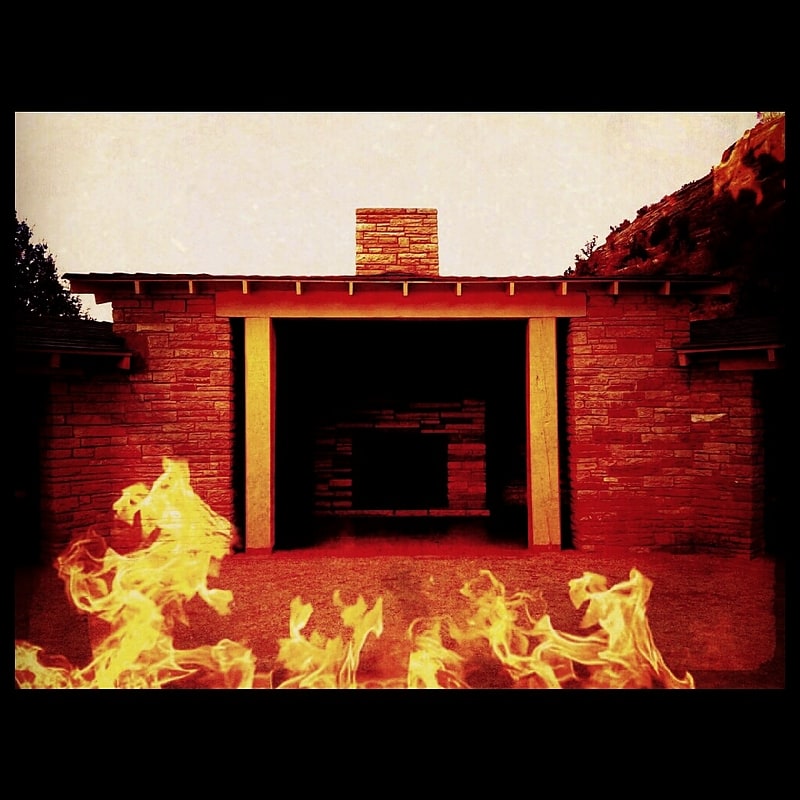
The Devils Kitchen Picnic Shelter in Colorado National Monument was designed by Harvey H. Cornell, Jerome C. Miller and Kenneth M. Saunders of the National Park Service Branch of Plans and Design in 1940. It was built by workers from the Civilian Conservation Corps and the Public Works Administration in 1941, in the National Park Service Rustic style. The shelter features three sandstone fireplaces, as well as toilets and service facilities.
Construction was carried out by craftsmen, known as LEM's (Local Experienced Men), with suitable skills, reputedly stonemasons of Italian descent. Much of the material came from Rim Rock Drive construction. The picnic shelter was built by the men of CCC camp NM-2-C.
The shelter is unusual due to its large size and diversified function.[10]